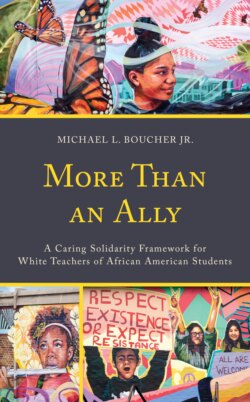Читать книгу More Than an Ally - Michael L. Boucher Jr. - Страница 18
На сайте Литреса книга снята с продажи.
Naming the Unmentionable: White Supremacy
ОглавлениеAs hooks (2013) explained, while people usually associate racism with overt “acts of aggression by whites against blacks.” White supremacy, as a way to understand social structures, “addresses the ideological and philosophical foundations of racism” (p. 177). White supremacism is the most divisive, cancerous, and self-defeating mental and social construct of our time, and yet it has largely gone unnoticed in the telling of U.S. history. The term White supremacy conjures up racist hate groups and Klan rallies burning crosses, and most educated people disavow that version of White supremacy.
No one wants to be labelled as a bad person and few phrases make people feel uncomfortable as being associated with racism or White supremacy. These words like these make White people profoundly uncomfortable. The power any phrase possesses to hurt others does not come from its sound or even its surface meaning. The meanings of words are important, but so is their social context (DiAngelo, 2017). Nice White people always want to avoid being called racist and want others to understand that they are looking for common ground (Renkle, 2018). Constructive conversations about racism are the often subverted by the feelings of White people insert themselves into the foreground in race conversations, and because of that, little has changed that truly removes White supremacist ideology from society.
When people tiptoe around the feelings of White people, they will always be in solidarity with whiteness. White supremacy is one of those terms that has a simple meaning, the assumption that White people are better than others, but is often unheard because it has been used in social context to describe the most violent and detestable sections of society.
Sociologist Robin DiAngelo (2017) has written extensively about the term: “White supremacy captures the all-encompassing centrality and assumed superiority of people defined and perceived as white, and the practices based upon that assumption. White supremacy is not simply the idea that whites are superior to people of color (although it certainly is that), but a deeper premise that supports this idea—the definition of whites as the norm or standard for human, and people of color as an inherent deviation from that norm.”
As DiAngelo (2018) explained, “White people raised in Western society are conditioned into a white supremacist worldview because it is the bedrock of our society and its institutions. Regardless of whether a parent told you that everyone was equal, or the poster in the hall of your white suburban school proclaimed the value of diversity, or you have traveled abroad, or you have people of color in your workplace or family, the ubiquitous socializing power of white supremacy cannot be avoided. The messages circulate 24-7 and have little or nothing to do with intentions, awareness, or agreement” (p. 129).
Allen and Liou (2018) explained, “In describing White supremacy as a social system, we are referring to a larger society that, despite times of what may seem like racial progress (e.g., the Civil Rights Era or Reconstruction), is fundamentally arranged to ensure that Whites remain in control of society, as they work to unjustly and immorally construct a higher social status over people of color” (p. 687).
DiAngelo (2017) challenged all White people to name the real issue in our politics and to begin the work of dismantling White supremacist ideologies in ourselves and the culture:
Naming white supremacy changes the conversation because it shifts the problem to white people, where it belongs. It also points us in the direction of the life-long work that is uniquely ours; challenging our complicity with and investment in racism. Yes, this work includes all white people, even white progressives. None of us have missed being shaped by the white supremacy embedded in our culture. (p. 33)
The ideology of White supremacy is found in every corner of American history and life, from the first Conquistadors and Pilgrims to the founding of a nation that espoused liberty but still protected slavery. It includes Jim Crow, crime bills that caused mass incarceration, and crowds calling for a wall on the southern border. White supremacist ideology allows White people to justify their lack of faithfulness to the democratic ideals of the founders and their own moral principles. Its purpose remains to define White people as superior. White supremacy, once it is named, can be seen everywhere in society and though it is often more hidden, in the school structure. As hooks and other scholars pointed out, it is the root of how school is structured from preschool to graduation.
